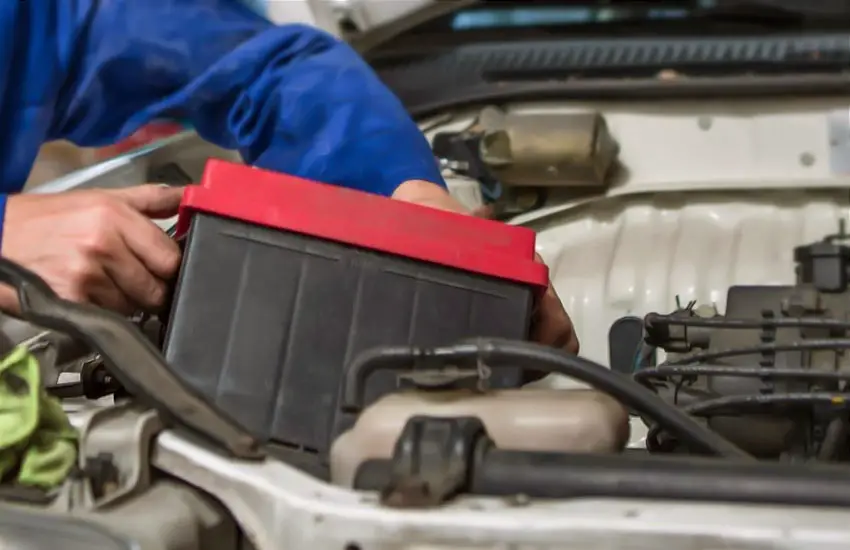As an Amazon Associate, I earn from qualifying purchases at no extra cost to you.
Hooked Battery Up Backwards Now Car Won’t Start: Solutions!
If you’ve ever jumped a car battery, you might know that connecting the cables can sometimes go wrong. Hooking up a battery backwards is one of those common mistakes that can lead to a lot of confusion and trouble. In this blog post, we will discuss what happens when you connect a battery the wrong way, how to fix the problem, and how to prevent it in the future. We'll break this down into sections to make it easier to understand.
Understanding the Basics of Car Batteries
What is a Car Battery?
A car battery is a rechargeable power source that supplies electricity to start your car’s engine. It also provides power to various electrical systems when the engine is off. Most car batteries are lead-acid batteries, which consist of lead plates and sulfuric acid. The battery stores energy in chemical form and converts it to electrical energy when needed.
How Does a Car Battery Work?
When you turn the key in your ignition, the battery sends electrical energy to the starter motor. This motor then turns the engine over, allowing it to start. Once the engine is running, the alternator takes over, recharging the battery while the car is in motion. This cycle allows your car to have a reliable source of power for starting and operating electrical systems.
Positive and Negative Terminals
Car batteries have two terminals: a positive (+) and a negative (-). The positive terminal is usually marked with a red cover or a plus sign, while the negative terminal is marked with a black cover or a minus sign. It is crucial to connect the cables correctly; the positive cable goes to the positive terminal, and the negative cable goes to the negative terminal. Connecting these incorrectly can cause damage to the car’s electrical system.
Symptoms of a Dead Battery
If your car won’t start, the first thing to check is the battery. Common signs of a dead battery include:
- Dim headlights
- Clicking sounds when turning the key
- Dashboard lights that do not turn on
- A battery warning light on the dashboard
Jump-Starting a Car
Jump-starting a car is a common way to revive a dead battery. You connect the dead battery to a charged battery using jumper cables. Make sure to connect the positive cable first, then the negative. This process should be done carefully to avoid any mistakes. Always consult your owner’s manual for specific instructions.
Importance of Correct Connections
Connecting the battery correctly is essential to prevent damage. If the cables are reversed, it can lead to several issues. The next section will explore what happens if you hook up a battery backwards.

What Happens When You Hook a Battery Up Backwards?
Immediate Effects
When you connect a car battery backwards, the immediate effects can be severe. The electricity will flow in the wrong direction through the electrical components of the vehicle. This reverse flow can cause electrical shorts and damage sensitive electronic parts.
Damage to the Alternator
One of the most vulnerable components of your car’s electrical system is the alternator. It is designed to charge the battery while the engine runs. If you connect the battery backwards, the alternator can be damaged due to the sudden surge of electricity. This damage can lead to expensive repairs and replacements.
Impact on Fuses
Most cars have fuses that protect electrical circuits. When the battery is connected backwards, these fuses can blow due to the surge of power. A blown fuse will interrupt the electrical flow to various components, causing some or all electrical systems in your car to stop working.
Effects on Electronic Control Units (ECUs)
Modern cars have multiple electronic control units (ECUs) that manage different systems, such as the engine, transmission, and safety features. Connecting the battery backwards can cause damage to these units. In some cases, they can become inoperable, requiring costly replacements or repairs.
Battery Damage
The battery itself can also be damaged if connected backwards. A lead-acid battery can suffer from internal short circuits, leading to reduced capacity or complete failure. In extreme cases, the battery can even leak or burst, creating a safety hazard.
Signs of Reverse Connection Damage
If you suspect you have connected your battery backwards, look for signs of damage. These can include:
- Smoke or burning smell from the battery or engine
- Unusual sounds when attempting to start the car
- Dashboard warning lights illuminated
- Inoperative electrical systems
Also Read: Why is My Car Going Through Coolant So Fast? Discover the Power Behind This Common Problem
Troubleshooting and Fixing the Issue After Hooking Up a Battery Backwards
Step 1: Safety First
Before attempting to troubleshoot or fix the issue, ensure your safety. Turn off the ignition and remove the key. If you see smoke or smell something burning, step back and allow the car to cool down. Make sure to wear safety glasses and gloves to protect yourself from any potential hazards.
Step 2: Disconnect the Battery
Once it is safe to proceed, disconnect the battery cables. Start with the negative cable first, then the positive cable. This will help prevent any sparks or further damage. If you find that the battery is leaking or damaged, do not attempt to handle it; contact a professional.
Step 3: Inspect for Damage
After disconnecting the battery, visually inspect the battery terminals and cables for any signs of damage. Look for burnt wires, melted plastic, or damaged connectors. Check the fuses as well; if you notice any blown fuses, they will need to be replaced.
Step 4: Test the Electrical Systems
Once you have disconnected the battery and inspected for damage, it’s time to test the electrical systems. You can do this by reconnecting the battery correctly, ensuring that the positive cable connects to the positive terminal and the negative cable to the negative terminal. Then, try starting the car.
Step 5: Check for Error Codes
If the car still won’t start, use an OBD-II scanner to check for error codes. This device connects to your car’s onboard diagnostic system and can reveal any issues related to the ECUs. If you find any error codes, research their meanings to understand what components may be damaged.
Step 6: Seek Professional Help
If you are unable to start the car or find damage, it may be time to consult a professional mechanic. They have the tools and experience to diagnose and repair electrical issues safely and effectively. Be honest about what happened, as this information will help them understand the situation better.
Preventing Future Mistakes
Double-Check Before Connecting
One of the best ways to prevent connecting a battery backwards is to double-check your connections before turning the ignition. Take a moment to ensure that the positive cable is attached to the positive terminal and the negative cable is attached to the negative terminal. This simple step can save you from potential damage.
Use Color-Coded Cables
Many jumper cables and battery cables are color-coded to help avoid mistakes. The positive cable is usually red, while the negative cable is black. Always remember these colors and use them as a guide when connecting your battery. If you are ever unsure, consult your owner’s manual for guidance.
Label Battery Terminals
If you are working on a vehicle where the battery terminals are not clearly marked, consider labeling them. Use waterproof labels to indicate which terminal is positive and which is negative. This small effort can help you remember the correct connections and prevent mistakes.
Educate Yourself on Battery Maintenance
Understanding how to maintain your car battery is essential for preventing issues. Regularly check your battery for signs of corrosion, leaks, or damage. Keeping the terminals clean and free from corrosion can also help ensure good electrical connections.
Have a Backup Plan
If you frequently jump-start vehicles or work on car batteries, consider investing in a portable jump starter. These devices can be a lifesaver when you need to start a car without the risk of making a mistake. They are easy to use and often come with clear instructions.
Consider Professional Assistance
If you are unsure about connecting a battery or handling electrical systems, don’t hesitate to seek professional help. Many mechanics and auto shops offer battery services and can assist with any questions or concerns you may have. Learning from professionals can help you become more knowledgeable about car maintenance.
Final Words
Hooking up a car battery backwards can lead to many problems, including damage to the battery, alternator, fuses, and electronic control units. Understanding how a car battery works and the consequences of incorrect connections is essential for any car owner. If you find yourself in this situation, prioritize safety, disconnect the battery, and inspect for damage. When in doubt, seek professional help. By following the tips in this guide, you can prevent future mistakes and keep your car running smoothly.
By being cautious and educating yourself about car batteries, you can avoid common mistakes and ensure your vehicle remains in good working condition. Remember, a little knowledge goes a long way in car maintenance.











